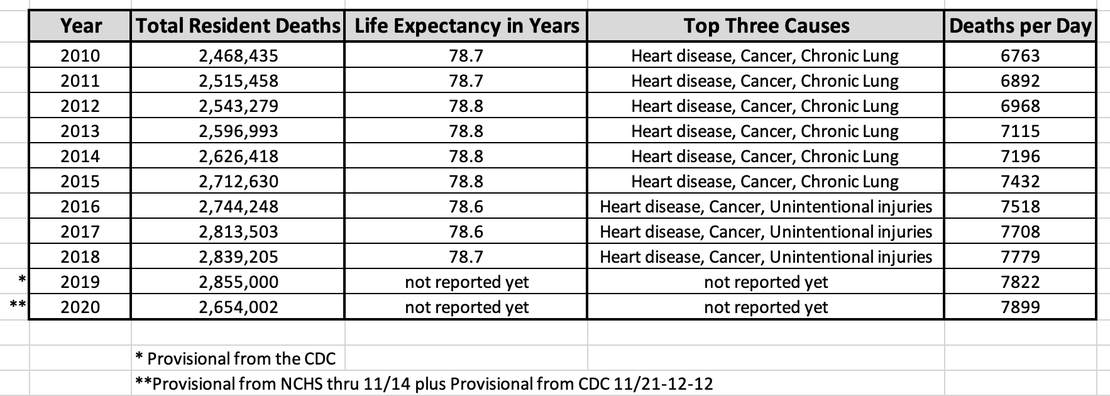Lockdowns have drastic consequences. Small businesses are closing for good at an alarming rate. Almost 100,000 were gone for good as of September, according to a Yelp survey. The impact on children and young adults is also enormous. Children are out of school, and a recent study shows the loss of learning is significant.
More heartbreaking are increases in mental health issues, abuse, and suicide. A few recent high-profile suicides among young teens, including one eleven-year-old on camera during a distance-learning session, drive the problem home. Opioid deaths are also increasing in over 40 states.
We are told this is the cost of controlling an unusually deadly virus by selected health experts and the corporate media. In fact, Bill Gates appeared on State of the Union with Jake Tapper and said that even with a vaccine, we won’t get back to “normal” until 2022. Dr. Anthony Fauci has told us that even with a vaccine, we will need to mask, social distance, and continue to beware.
One would think in light of these dire predictions and given the horrible toll the response has taken on the economy and young people, the excess deaths due to COVID-19 would be through the roof. But federal data says that does not appear to be the case. The following chart shows annual deaths in the United States, life expectancy, top causes of death, and average deaths per day in the country. Data for 2020 is provisional through December 12th, and all data is taken from the CDC or the National Center for Health Statistics (NCHS):

It appears that an excessive number of deaths for the year is not likely. To reach the level of total deaths in any year since 2017, the United States would need to experience between 8,395 to 10,579 deaths per day every day beginning on December 13th. This would be quite a feat given the fact that the case and infection fatality rates for COVID-19 have fallen significantly since the early pandemic with improved treatment.
This data supports an observation Neal Ferguson from the Imperial College made in testimony earlier this year. Ferguson noted the following when he testified in front of the U.K. Parliament:
“We don’t know what the level of excess deaths will be in this epidemic,” Ferguson said. In other words, we don’t know the extent to which COVID-19 will increase annual deaths above the level that otherwise would have been expected. “By the end of the year, what proportion of those people who’ve died from COVID-19 would have died anyhow?” Ferguson asked. “It might be as much as half to two-thirds of the deaths we’re seeing from COVID-19, because it’s affecting people who are either at the end of their lives or in poor health conditions. So I think these considerations are very valid.”
From the comparison of annual deaths from all causes, it appears the COVID death percentage may be even higher. In these deaths that may have been pulled forward, we have seen excess deaths with dementia and heart disease patients who contracted COVID-19. Further, researchers in New Jersey found that 89% of patients who died with COVID-19 had a Do Not Resuscitate (DNR) order in place before testing positive for the virus in three hospitals. Having a DNR generally means an individual has a terminal diagnosis. In this study, that would mean nearly 9 out of 10 deaths were pulled forward.
Even in an analysis of deaths during the height of the pandemic, from March 1st through August 1st, there is absolutely no correlation between public policy, such as lockdowns and mask requirements, and excess deaths. Georgia and Florida experienced a ratio of 1.16 and 1.17 between observed and expected deaths. These states closed late in March and opened in late April or early May.
New York and New Jersey, which had some of the strictest measures in place for months, saw a ratio of 1.65 and 1.60. Florida and Georgia have also had a persistently lower deaths-per-100,000 rate than New York and New Jersey for the entire pandemic. They come in at roughly half of the northern states, despite having almost no mandatory restrictions.
A study in the U.K. has noted a pattern consistent with Ferguson’s prediction, the New Jersey study, and the lack of correlation between pandemic control measures and outcomes:
Conclusion: a significant amount of displacement has occurred that is reflected in the lower than expected deaths in older age groups and Alzheimer and dementia deaths through the summer. In-hospital deaths with a positive covid test are the highest for any setting; however, they contribute much less to the overall excess in deaths. Deaths in the home remain persistently high, and yet they receive little attention.
In other words, because of COVID-19, deaths occurred a few months earlier than might have been expected in particular populations, including the elderly and dementia patients. The increase in deaths at home concerned U.K. health officials earlier this year because they feared they were a result of people not seeking care or not receiving care because of the pandemic.
It is long past the time for the corporate media and health bureaucrats to pay attention to dissenting voices on lockdowns. The current trend appears consistent with COVID-19 accelerating deaths in people, mostly the elderly, who are already suffering from advanced illness. Pneumonia does this, as do certain types of influenza. History will look back on the severe and extended reaction to the COVID-19 pandemic as one of the greatest overreactions in history.
Editor’s Note: Want to support PJ Media so we can keep telling the truth about China and the virus they unleashed on the world? Join PJ Media VIP and use the promo code WUHAN to get 25% off your VIP membership.










Join the conversation as a VIP Member